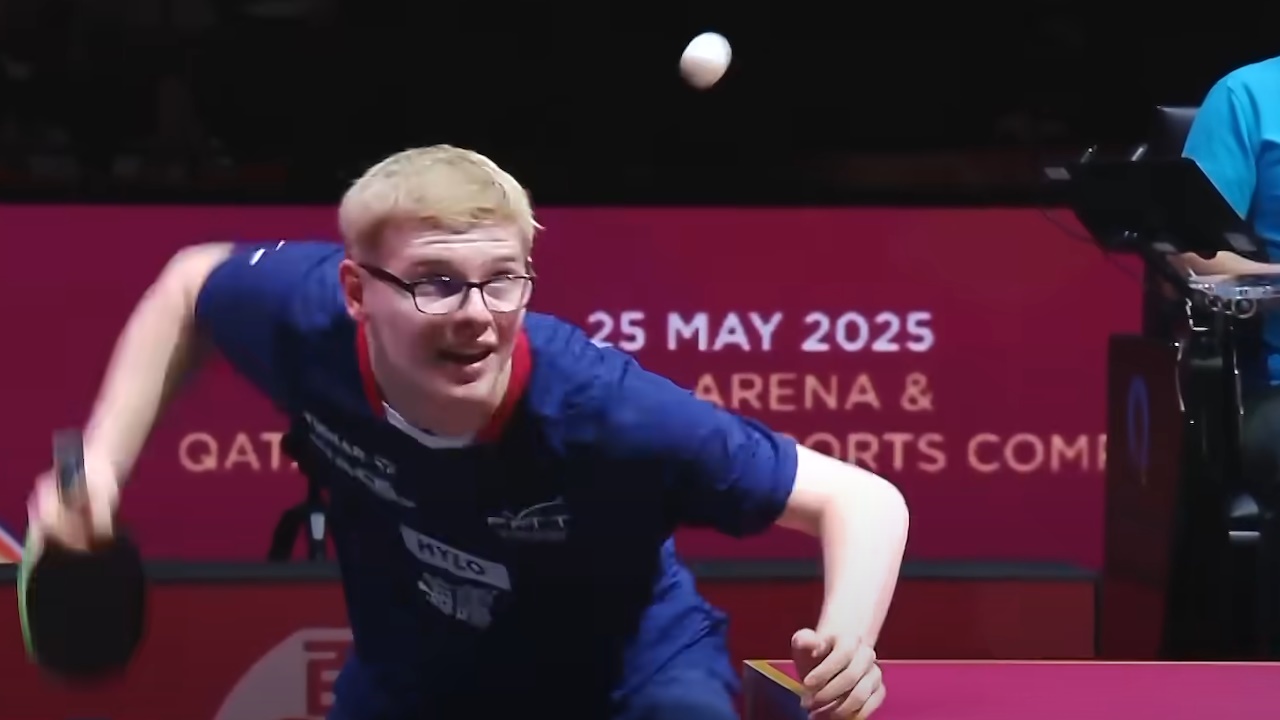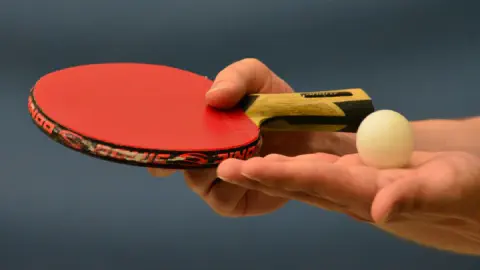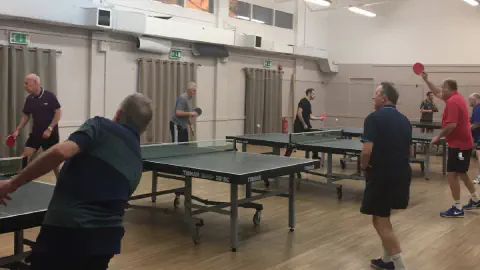Félix Lebrun: France's Teenage Phenom Revolutionizing European Table Tennis
By: Simon
May 27, 2025 | Updated: October 22, 2025
Credit: ©World Table Tennis
Félix Lebrun has established his position among the world elite at #7 as a teenage sensation, combining technical brilliance with tactical maturity well beyond his years to become Europe’s brightest table tennis prospect. The 18-year-old French prodigy has already collected Olympic bronze and numerous victories over established elite players, though his journey faced a setback at the 2025 World Table Tennis Championships in Doha with a heartbreaking seven-game defeat to South Korea’s An Jaehyun in the Round of 16, highlighting the intense competition and pressure now following this extraordinary young talent.
Personal Background
Félix Lebrun, born on August 19, 2006, in Montpellier, France, represents the new wave of European table tennis excellence. Raised in a table tennis family, Félix has been immersed in the sport since childhood alongside his older brother Alexis, who is also a professional player. The brothers trained at the Montpellier Table Tennis Club under their father Stéphane Lebrun, himself a former high-level player who competed for the French national team in the 1990s.
This table tennis-centric upbringing provided Félix with an exceptional foundation in the sport. By age 12, he was already showing remarkable potential in French youth competitions. His development accelerated when he joined the French national training center (INSEP) as a teenager, where he benefited from elite coaching and sparring partners. This structured environment helped refine his natural talents while instilling professional training habits.
Félix’s rapid progression through the ranks of European table tennis demonstrates not just technical precocity but exceptional mental maturity. Despite his youth, he has displayed remarkable composure when facing established veterans on the world stage. His emergence coincided with France’s broader resurgence in men’s table tennis, with Lebrun serving as the centerpiece of this revival during the home Olympics in Paris 2024, where he captured a historic bronze medal that ended France’s 32-year drought for an individual Olympic table tennis medal.
What sets Lebrun’s background apart is how quickly he transitioned from junior prospect to legitimate world-class contender. While many talented juniors struggle with this transition, Félix embraced the pressures of senior competition, seemingly unfazed by the expectations placed upon his young shoulders as he continues to represent the bright future of French and European table tennis on the global stage.
Physical Attributes & Playing Style
Félix Lebrun’s playing style is defined by a fascinating combination of modern European and Asian influences, making him one of the most technically complete young players in world table tennis. Standing at approximately 5'11" (180cm), Lebrun possesses an ideal physical frame for modern table tennis—tall enough to generate power but nimble enough for explosive movement. His lean, athletic build supports exceptional footwork that allows him to cover the table efficiently while maintaining proper positioning for both offensive and defensive sequences.
What immediately stands out about Lebrun’s style is his left-handed shakehand grip, which naturally creates challenging angles for right-handed opponents who comprise the majority of the field. His stance is slightly more upright than many Asian players, typical of the European school, but he maintains a compact ready position that enables quick transitions between forehand and backhand.
Lebrun’s playing identity centers on aggressive, high-tempo attacking play with exceptional ball placement rather than overwhelming power. He excels in the mid-distance counter-loop game, where his exceptional timing and feel for the ball allow him to redirect opposing attacks with pinpoint accuracy. Unlike many young players who rely purely on athleticism, Lebrun demonstrates remarkable tactical awareness, patiently constructing points while recognizing precisely when to increase attacking pressure.
His game rhythm is characterized by controlled aggression—maintaining consistent pressure without overplaying or forcing unnecessary errors. This measured approach to attacking table tennis has become his signature, allowing him to outlast more experienced opponents through a combination of physical stamina and tactical discipline. As a left-hander, he naturally excels at wide-angle plays that stretch opponents out of position, particularly using his backhand flick to exploit short balls over the table.
Félix represents the modern European player who has successfully incorporated elements of the Chinese technical model while maintaining distinctive European tactical approaches, creating a hybrid style that has proven effective against elite competition despite his relative youth. This style was on full display during his bronze medal run at the Paris Olympics, where his adaptability and technical precision allowed him to overcome more experienced opponents.
Technical Analysis
Félix Lebrun’s technical profile showcases a remarkably complete game for a player of his age, with sophisticated elements typically found in more experienced players. His forehand technique features a compact backswing with excellent wrist engagement, allowing him to generate significant spin while maintaining control. What distinguishes his forehand is not raw power but exceptional placement and variation—he can place the ball to all corners with nearly identical stroke mechanics, making his intentions difficult to read.
His backhand represents perhaps his greatest technical strength. Lebrun employs a modern, close-to-table backhand loop with minimal backswing, enabling him to attack backspin balls with immediate initiative. This technique is particularly effective given his left-handed orientation, as it allows him to angle balls into uncomfortable positions for right-handed opponents. His backhand block is equally impressive, featuring soft hands and precise control when absorbing power, allowing him to neutralize even the heaviest attacks from opponents.
Lebrun’s service game demonstrates sophisticated variation and deception. He utilizes a diverse repertoire including short backspin, sidespin, and floating serves with nearly identical motion but different spin characteristics. His service strategy typically aims to create third-ball attack opportunities rather than winning points directly. Similarly, his receive technique excels against both long and short serves—against short serves, his flick attack (particularly with the backhand) allows him to immediately seize initiative, while against long serves, his early timing helps neutralize the server’s advantage.
His movement technique is characterized by small, efficient steps that maximize balance during transitions, with exceptional weight transfer during stroke execution. This technical efficiency is particularly evident during rapid exchanges, where Lebrun rarely appears hurried or off-balance. One area still developing is his far-table defensive game, though his counter-attacking instincts often prevent him from needing to resort to defensive chopping or lobbing.
What truly distinguishes Lebrun’s technical execution is his exceptional touch and feel for the ball, allowing him to modulate spin and speed with subtle adjustments rather than complete technique changes. This advanced ball control enables him to maintain consistency even when implementing complex tactical patterns against elite opposition. These technical qualities were evident during his recent matches at the 2025 World Championships in Doha, particularly in his hard-fought seven-game defeat to South Korea’s An Jaehyun in the Round of 16, showing that even with superior technique, the margins at elite level remain exceptionally small.
Tactical Approach
Félix Lebrun’s tactical intelligence belies his youth, demonstrating strategic sophistication typically associated with far more experienced players. His fundamental approach centers on controlling rally initiative through serve and receive quality, then maintaining pressure through precise ball placement rather than raw power. This tactical maturity is evident in how he constructs points—patiently building advantage before executing decisive attacks rather than forcing premature winners.
Against defensive specialists, Lebrun shows remarkable patience, avoiding the common young player trap of impatience. He systematically varies placement, spin, and tempo to gradually wear down defensive players, often using his backhand attack down the line to disrupt their positioning. When facing power-oriented opponents, he excels at neutralizing initial attacks through quality blocking and counter-looping, then exploiting the resulting midcourt balls with precise placement to corners.
Lebrun’s adaptability during matches represents one of his greatest tactical strengths. He can effectively shift between aggressive, counter-attacking, and controlled play based on both the opponent and match situation. This versatility makes him difficult to prepare against, as he rarely relies on a single tactical pattern throughout a match. His coach, Nathanaël Molin, has noted this adaptability as a key factor in his rapid rise against established players.
In tournament settings, Lebrun demonstrates sophisticated energy management, calibrating his intensity across multiple matches to maintain peak performance. This approach was evident during his Olympic bronze medal campaign in Paris 2024, where he maintained consistent quality across consecutive high-pressure matches. However, his recent experience at the 2025 World Championships in Doha, where he fought hard but ultimately lost a seven-game thriller to An Jaehyun (3-4) in the Round of 16 after earlier defeating Oh Junsung and Manush Shah in convincing fashion, suggests that managing the increasing expectations and pressure presents ongoing tactical and mental challenges.
His left-handedness features prominently in his tactical approach, particularly in serve and first-attack sequences where he can create challenging angles. Lebrun’s game intelligence is evident in how he leverages this natural advantage, frequently directing play toward opponent backhands early in rallies, then exploiting the created openings with angled attacks to the forehand side.
While still developing, Lebrun’s match temperament shows remarkable composure under pressure, maintaining tactical discipline in crucial points rather than resorting to unnecessarily risky play, a maturity that distinguishes him from many players in his age bracket. This mental strength was critical during his Olympic medal campaign and will be essential as he processes the disappointment of his 2025 World Championships performance, where he came tantalizingly close to a quarterfinal appearance.

Equipment Details
Félix Lebrun’s equipment choices reflect his modern, attacking style while incorporating elements that enhance his technical strengths. He uses a Stiga Cybershape carbon blade, part of the newer generation of geometrically optimized blades featuring a unique hexagonal shape. This design choice aligns with his play style, as the Cybershape provides excellent control while maintaining sufficient speed for his attacking sequences without sacrificing precision.
For rubbers, Lebrun employs Stiga DNA Pro H on both forehand and backhand surfaces. This selection demonstrates his balanced approach to equipment—DNA Pro H offers medium-high speed with excellent spin sensitivity, supporting both his counter-looping game and close-table exchanges. The rubber’s characteristics particularly complement his backhand technique, providing sufficient grip for his aggressive flicks while maintaining control during blocking sequences.
His equipment setup has remained relatively consistent throughout his rise up the rankings, suggesting he values familiarity and consistency over frequent experimentation. This stability in equipment choice aligns with his measured approach to development, focusing on technical mastery rather than seeking equipment-based advantages.
Lebrun’s blade thickness and weight fall within standard parameters for modern attackers, avoiding extremely lightweight or heavy equipment that might compromise control. His rubber thickness likely follows contemporary trends toward maximum thickness (around 2.1mm) to maximize spin potential without sacrificing control.
As a Stiga-sponsored athlete, Lebrun benefits from customization opportunities within their product range, though he appears to favor mainstream production equipment rather than heavily customized setups. This approach reflects his technical versatility—relying on adaptable, well-rounded equipment rather than highly specialized tools optimized for particular techniques.
Interestingly, Lebrun’s equipment choices mirror the modern European approach to table tennis technology—embracing innovative design elements while maintaining core performance characteristics that support traditional European technical fundamentals. His equipment selection ultimately serves his playing identity rather than defining it, providing the necessary platform for his technical skills without introducing unnecessary variables.
Career Achievements
Félix Lebrun’s career trajectory has been nothing short of meteoric since 2022. His crowning achievement came during the 2024 Paris Olympics, where he secured a bronze medal in the individual event, ending France’s 32-year drought for an individual Olympic table tennis medal. At just 17 years old during the Games, Lebrun defeated Brazil’s Hugo Calderano in the bronze medal match, establishing himself as one of the sport’s premier talents on home soil.
Prior to his Olympic success, Lebrun made significant impacts on the senior international circuit. At the 2023 European Championships, he reached the semifinals at just 16 years old, defeating several established European stars. His gold medal at the 2023 European Games further established his status as Europe’s rising star in the sport.
On the WTT circuit, Lebrun has collected impressive results against world-class opposition. His consistent performance at WTT Contender and Challenge events has propelled his rapid rise up the world rankings, reaching world #7 by May 2025—an extraordinary achievement for a player still in his teenage years.
While his singles journey at the 2025 ITTF World Table Tennis Championships in Doha ended with a heartbreaking seven-game loss to South Korea’s An Jaehyun (3-4) in the Round of 16, his performances throughout the tournament showcased his world-class capabilities. He dispatched Lubomir Pistej and Manush Shah without dropping a game in the early rounds and defeated Oh Junsung 4-2 in the Round of 32 before his marathon battle with An Jaehyun.
In doubles competition at the same championships, Félix partnered with his brother Alexis as the tournament’s top seeds, advancing to the semifinals before falling to Taiwan’s Kao/Lin partnership 1-3. Their quarterfinal victory over Sweden’s Falck/Karlsson (3-1) and earlier wins over Spain’s Berzosa/Perez (3-2) and Iran’s Faraji/Keshavarzi (3-0) demonstrated their formidable partnership despite the eventual semifinal disappointment.
His junior career achievements were similarly impressive before his rapid transition to senior competition. He claimed multiple medals at European Youth Championships and established himself as one of the top junior players in Europe. The speed of his progression from junior prospect to Olympic medalist represents one of the fastest ascents in recent table tennis history.
As part of the French national team, he has become the cornerstone of their resurgence in team competitions, helping France reestablish itself as a legitimate contender in European and world team events. His continued development and response to recent setbacks will be closely watched as he aims to fulfill his potential as one of table tennis’s most promising talents.
Training Methodology
Félix Lebrun’s training methodology combines traditional European technical development with modern physical preparation and psychological approaches. As part of the French national training center at INSEP, his daily routine integrates multiple technical sessions with specific physical conditioning designed to support his playing style. Morning sessions typically focus on fundamental technique refinement, with particular emphasis on service, receive, and first-ball attack sequences—areas crucial to modern table tennis success.
His practice regimen places heavy emphasis on multi-ball training for specific technical components, particularly his backhand attack and transition movements between wing positions. This approach allows for high-volume repetition of key skill elements while gradually increasing execution speed. Afternoon sessions generally center on match-play scenarios against varied sparring partners, including both defenders and aggressive attackers, ensuring tactical adaptability.
The French coaching methodology evident in Lebrun’s development emphasizes tactical understanding alongside technical execution. Video analysis features prominently in his preparation, with detailed study of both his own performances and potential opponents. This analytical approach has accelerated his tactical development, allowing him to identify and exploit opponent patterns despite his relative inexperience at the senior level.
Following his Olympic bronze medal success, Lebrun’s training has intensified with greater focus on maintaining consistency against the world’s elite. His recent performance at the 2025 World Championships in Doha, where he was eliminated in a seven-game thriller in the Round of 16, will undoubtedly trigger adjustments to his training approach, particularly in managing high-pressure situations in decisive games.
Physical conditioning forms a crucial component of his regimen, with specialized focus on explosive movement, core stability, and endurance—all essential for his dynamic playing style. Unlike previous generations of European players, Lebrun’s physical training is fully integrated with his technical development rather than treated as a separate component.
Mental preparation represents a key emphasis in Lebrun’s development program. Working with sports psychologists, he has developed robust pre-match routines and in-match reset protocols that maintain his focus during high-pressure situations. This psychological framework proved particularly valuable during his Olympic campaign and will be further refined following his World Championship experience, where mental resilience in deciding games will likely become a training priority.
His training environment benefits from family support, with brother Alexis serving as both training partner and competitive reference. Together they form one of the world’s top doubles partnerships, as evidenced by their semifinal run at the 2025 World Championships as the tournament’s top seeds. This synchronized training enhances both singles and doubles capabilities. The combination of structured institutional training at INSEP with supportive family dynamics has created an ideal development environment, balancing rigorous professional standards with psychological security.
Félix Lebrun vs An Jaehyun Match Highlights ITTFWorlds2025 [Video]
Influence & Legacy
Despite his youth, Félix Lebrun has already established a significant influence on European table tennis while building the foundation for a potentially landmark legacy. His emergence represents a crucial bright spot for European table tennis amid continued Asian dominance at the highest levels. As European men have struggled to consistently challenge for major global titles over the past decade, Lebrun’s Olympic bronze medal offers renewed hope for continental competitiveness.
His playing style is already influencing younger French and European players, who see in Lebrun a viable technical model that can compete with Asian approaches. His success demonstrates that European players can incorporate elements of the Chinese technical school while maintaining distinctive European tactical approaches, creating an effective hybrid style. This influence is particularly evident in French youth development, where his rapid rise has inspired increased participation and ambition.
For French table tennis specifically, Lebrun’s Olympic success has been transformative. His bronze medal at the Paris Games ended a 32-year drought for individual Olympic medals in table tennis for France, creating a national hero in the process. He has become the face of French table tennis despite his youth, featured prominently in promotional materials and media coverage. His success has reignited public interest in table tennis within France, creating opportunities for the sport to expand its profile and participation base.
From a technical influence perspective, Lebrun’s effective implementation of the modern close-to-table backhand attack has provided a template for European players looking to adapt this predominantly Asian technique. His success with this approach demonstrates its viability within European playing systems and training methodologies.
While his legacy continues to develop, Lebrun’s Olympic medal has already made him a transformative figure in European table tennis history. His achievement in Paris has catalyzed renewed investment and interest in table tennis across Europe, potentially shifting the sport’s global balance of power that has tilted heavily toward Asia in recent decades.
Though his recent experience at the 2025 World Championships in Doha, where he fell just short in a seven-game thriller in the Round of 16, reminds us of the challenges that come with elite competition, Lebrun’s impact on French and European table tennis is already profound, making him one of the sport’s most influential young players regardless of his future achievements. How he responds to these competitive challenges will form an important chapter in his continuing legacy.
Current Standing & Context Among Peers
Félix Lebrun’s current standing at world #7 as of May 27, 2025, places him in elite company as one of the youngest players ever to reach the top 10 in the men’s world rankings. This position establishes him as France’s highest-ranked player and among Europe’s elite, marking him as the continent’s most promising young talent. His rapid rise through the rankings—advancing approximately 700 positions in just over two years—demonstrates both his exceptional ability and the immediate impact he has made on the senior circuit.
Among his peer group of players under 20, Lebrun has established himself as perhaps the most accomplished, consistently outperforming others in his age bracket at senior events. This standing is particularly noteworthy given the traditional tendency for male table tennis players to reach their peak performance in their mid-to-late twenties, suggesting Lebrun may still be years from realizing his full potential.
His recent experience at the 2025 World Table Tennis Championships in Doha, where he battled valiantly through multiple rounds before falling to South Korea’s An Jaehyun in a seven-game thriller (3-4) in the Round of 16, demonstrates both his world-class capabilities and the intense competition at the elite level. This tournament also showcased his doubles prowess, as he and brother Alexis reached the semifinals as the event’s top-seeded partnership before losing to Taiwan’s Kao/Lin team.
Within European table tennis, he represents the vanguard of a new generation challenging the established order. While veterans like Timo Boll and Dimitrij Ovtcharov have carried European hopes for nearly two decades, Lebrun leads a youth movement that includes players like Truls Moregard and his brother Alexis seeking to elevate European competitiveness against Asian dominance.
In the global context, Lebrun has already proven capable of defeating multiple Chinese elite players in individual matches, though achieving consistent success against the Chinese national team members remains the ultimate benchmark for any player with championship aspirations. His playing style and approach position him well for this challenge, as he combines sufficient technical quality with the tactical variability needed to disrupt the Chinese system.
Like a carefully crafted sidespin serve that appears simple yet creates complex challenges for opponents, Lebrun’s emergence represents a deceptively powerful shift in the European table tennis landscape—seemingly sudden yet built on years of methodical development, with effects that will continue to unfold in the coming years. His response to recent competition, including his narrow defeat at the World Championships, will be closely watched as he continues his journey toward fulfilling his immense potential.
Follow Félix Lebrun on Social Media
FULL MATCH | Lebrun/Lebrun vs Kallberg/Moregard | MD R16 | #ITTFWorlds2025 [Video]
Featured Articles
Dive into in-depth stories, exclusive interviews, and expert advice from the world of table tennis. Discover strategies, player spotlights, and behind-the-scenes insights.

Ping Pong Revolution: How Table Tennis Transforms Homes, Offices, and Communities
Table tennis is uniquely positioned as one of the most versatile recreational activities available today. This comprehensive article explores the transformative impact of ping pong across three …

Basic Equipment Needed to Play Table Tennis
What is the basic equipment that you need to get started with playing ping pong? Our guide to the very basic table tennis equipment required to go ahead and start to play. A guide to the basics of …

Is Ping Pong Good Exercise? The Top Health Benefits Explained
Table tennis is great exercise both for mind and body. You can use ping pong to keep fit alongside other exercise programs and raise your overall activity levels to lose weight and keep your mind …

Ping Pong Revolution: How Table Tennis Transforms Homes, Offices, and Communities
Table tennis is uniquely positioned as one of the most versatile recreational activities …

Basic Equipment Needed to Play Table Tennis
What is the basic equipment that you need to get started with playing ping pong? Our guide …

Is Ping Pong Good Exercise? The Top Health Benefits Explained
Table tennis is great exercise both for mind and body. You can use ping pong to keep fit …

